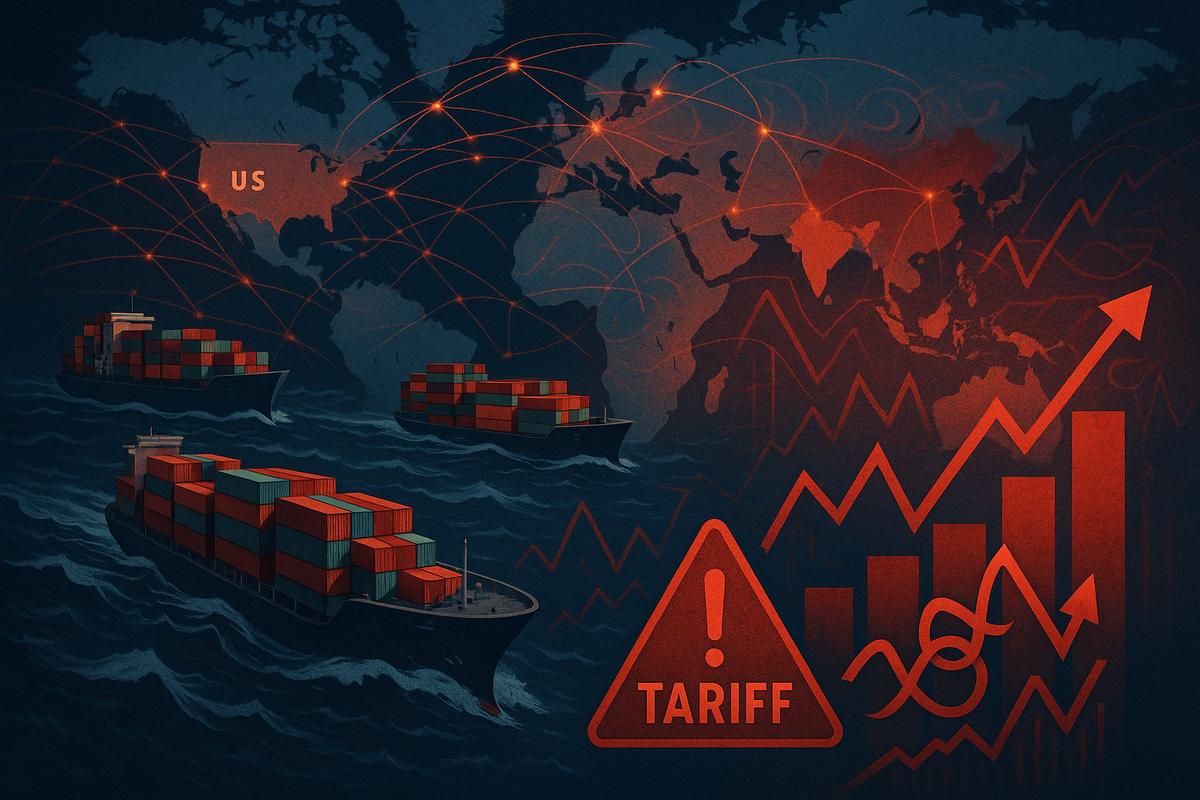
The global economic landscape is bracing for significant turbulence as the United States implements a fresh wave of tariffs, targeting Indian products and initiating a major investigation into furniture imports. These aggressive protectionist measures, enacted by the U.S. administration in 2025, are sending shockwaves through international trade, exacerbating inflationary pressures, and intensifying fears of stagflation – a perilous combination of high inflation and stagnant economic growth.
The immediate implications are far-reaching, threatening to disrupt established supply chains, increase consumer costs, and force businesses worldwide to re-evaluate their sourcing and manufacturing strategies. As the average effective U.S. tariff rate surges to levels not seen in decades, the global economy finds itself at a critical juncture, grappling with heightened uncertainty and the specter of a full-blown global trade war.
A New Chapter in Trade Protectionism Unfolds
The recent escalation in trade tensions is marked by two significant developments: the imposition of an additional 25% tariff on a broad range of Indian goods and the launch of a "major tariff investigation" into U.S. furniture imports. These actions, effective in late August and early October 2025 respectively, underscore a growing trend of protectionism that is reshaping international commerce.
The additional 25% tariffs on Indian products, bringing the total tariff rate to 50% for many items, were officially justified by the U.S. administration as a response to India's continued purchases of Russian oil. This move, effective August 27, 2025, targets a wide spectrum of Indian exports, including textiles, gems and jewelry, leather, machinery, furniture, and marine products. While pharmaceuticals, electronics, automobiles (passenger vehicles), steel, copper, and aluminum are exempt, the impact on India's economy is expected to be severe. As the U.S. is India's largest export market, projections suggest a potential reduction of India's exports to the U.S. by as much as 43% in affected sectors, from $86.5 billion to $49.6 billion, threatening hundreds of thousands of jobs. Labor-intensive sectors like textiles and apparel, and gems and jewelry, are particularly vulnerable, with some analysts describing the new duties as "doomsday" for the jewelry industry. Indian officials have condemned the tariff hike as "unfair, unjustified, and unreasonable," vowing to protect national interests, though no retaliatory measures have been announced yet.
Concurrently, President Donald Trump announced a "major tariff investigation" into furniture imports, with plans to levy duties within the next 50 days, by October 2025. This investigation, reportedly conducted under Section 232 of the 1962 Trade Expansion Act, which allows for tariffs based on national security concerns, covers timber, lumber, and wood products, including furniture. The stated objective is to revive domestic furniture manufacturing in states like North Carolina, South Carolina, and Michigan. While a specific rate is yet to be determined, these tariffs would impact major furniture exporting countries to the U.S., including Vietnam, China, Malaysia, Taiwan, Canada, Italy, and Mexico. Vietnam and China alone accounted for $12 billion in furniture and fixtures exports to the U.S. in 2024. Following the announcement, stock prices for major retailers like Wayfair (NYSE: W) and RH (NYSE: RH) experienced significant drops, reflecting immediate market apprehension. Furniture prices have already been on an upward trend in recent months due to existing tariffs on goods from countries like China and Vietnam.
Winners and Losers in the Tariff Tug-of-War
The escalating trade tensions are creating a clear divide between potential winners and losers, with significant implications for public companies and entire industries. The immediate beneficiaries, if any, are likely to be domestic manufacturers in the U.S. that produce goods similar to those now subject to higher tariffs.
For instance, U.S. furniture manufacturers, particularly those in states like North Carolina, South Carolina, and Michigan, could see a resurgence in demand as imported furniture becomes more expensive. Companies like La-Z-Boy (NYSE: LZB) or Ethan Allen Interiors (NYSE: ETD), which have significant domestic manufacturing capabilities, might gain a competitive edge. However, even these companies could face increased costs for imported raw materials or components, offsetting some of the benefits. The long-term viability of this strategy hinges on whether domestic production can scale efficiently and competitively without simply passing on higher costs to consumers.
On the losing side, the impact is more immediate and widespread. Indian exporters, especially those in the textile, gems and jewelry, leather, and marine product sectors, face a devastating blow. Companies heavily reliant on the U.S. market for their exports will see their profit margins shrink dramatically or disappear entirely, potentially leading to job losses and business closures. While specific Indian public companies are not listed in the research, the broader impact on India's export-oriented industries will be severe.
U.S. retailers and importers of furniture, such as Wayfair (NYSE: W) and RH (NYSE: RH), are already feeling the pinch, as evidenced by their stock price drops. These companies will either have to absorb the increased tariff costs, pass them on to consumers, or find alternative, potentially more expensive, sourcing options. Passing on costs will likely lead to reduced sales volume, while absorbing them will erode profitability. The search for new suppliers could also lead to higher logistical costs and longer lead times, further impacting their bottom line. Consumers, ultimately, are among the biggest losers, as they will face higher prices for a wide array of goods, from clothing to furniture, diminishing their purchasing power.
Industry Impact and Broader Implications
These tariff escalations are not isolated incidents but rather integral to a broader trend of increasing protectionism that is fundamentally altering global trade dynamics. The average effective U.S. tariff rate, which has surged throughout 2025, reaching an estimated 18.6% by August, is a stark indicator of this shift, marking levels not seen since the 1930s. This aggressive stance is ushering in what many are calling a "new global trade order" and a "global trade war," characterized by unprecedented uncertainty and volatility.
The most significant ripple effect is the accelerated reconfiguration of global supply chains. Companies are actively seeking to reduce their reliance on single-country sourcing, particularly from China, and are exploring "reshoring" manufacturing to the U.S. or "friend-shoring" to allied nations. While this aims for greater resilience and reduced geopolitical risk, it involves substantial upfront costs for relocating production facilities, retooling, and establishing new logistical networks. These shifts are likely to lead to higher production expenses in the short to medium term, as new supply chains are often less efficient than established ones. This trend will impact a vast array of industries, from electronics to automotive, as companies like Apple (NASDAQ: AAPL) and Tesla (NASDAQ: TSLA) continue to diversify their manufacturing footprints.
The regulatory and policy implications are equally profound. The use of Section 232 of the 1962 Trade Expansion Act for furniture imports, typically reserved for national security concerns, signals a broader interpretation of trade law to justify protectionist measures. This could set a precedent for future tariffs on other goods, further expanding the scope of trade disputes. Historically, such widespread tariff implementations have often led to retaliatory measures from trading partners, as seen in past trade disputes with China. While India has not yet announced retaliation, the potential for a tit-for-tat escalation remains a significant concern, further destabilizing global commerce. The World Trade Organization (WTO) has already lowered its 2026 global merchandise trade growth forecast, and global GDP growth is projected to slow, potentially falling below 2% in 2025 from 3% in 2024, with risks of a global recession if trade tensions escalate further. Emerging Asian economies, with their interconnected supply chains, are particularly exposed to these disruptions.
What Comes Next: Navigating a Turbulent Future
The path forward is fraught with both challenges and potential opportunities, demanding strategic pivots and adaptations from businesses and policymakers alike. In the short term, companies heavily reliant on imports from India or those in the furniture sector will need to immediately assess their supply chains and pricing strategies.
For importers of Indian goods, the immediate challenge is to either absorb the 25% tariff increase, pass it on to consumers, or rapidly identify alternative sourcing countries. This could lead to a scramble for new suppliers in Southeast Asia or other regions, potentially driving up demand and prices in those markets. Furniture retailers and manufacturers will face similar pressures, needing to decide whether to invest in domestic production, seek new international suppliers, or accept higher costs for existing imports. This could lead to a temporary shortage of certain goods or a significant increase in their retail prices.
In the long term, the trend towards supply chain diversification and reshoring is likely to accelerate. This presents opportunities for domestic manufacturing sectors in the U.S. and for countries that are considered "friend-shoring" partners. Companies that can adapt quickly by investing in automation, localizing production, or building more resilient, geographically diverse supply chains will be better positioned to weather future trade shocks. This could also spur innovation in manufacturing processes and logistics.
However, the overarching challenge remains the specter of stagflation. The Federal Reserve is grappling with tariff-driven inflation, which has complicated its monetary policy decisions and prevented interest rate cuts that were initially planned for 2025. This creates an "unprecedented challenge" for the Fed in balancing its dual mandate of price stability and maximum employment. Potential scenarios range from a continued slow grind of high inflation and modest growth to a more severe economic downturn if trade tensions escalate further and consumer spending significantly contracts due to higher prices. Investors should closely monitor inflation data, central bank statements, and any further announcements regarding trade policy.
Conclusion: A New Era of Economic Uncertainty
The recent tariff escalations mark a significant turning point in global trade, ushering in an era of heightened economic uncertainty and complex challenges. The additional 25% tariffs on Indian products and the major tariff investigation into U.S. furniture imports are not merely isolated trade disputes; they are symptomatic of a broader shift towards protectionism that carries profound implications for businesses, consumers, and the global economy.
The key takeaways from this event are clear: global supply chains are undergoing a fundamental transformation, inflationary pressures are intensifying, and the risk of stagflation is a tangible threat. Businesses must prioritize resilience and adaptability, exploring diversified sourcing, localized production, and innovative strategies to mitigate the impact of trade barriers. Consumers, in turn, should brace for higher prices across a range of goods.
Moving forward, the market will be characterized by increased volatility and a need for careful navigation. Investors should closely watch for further policy announcements, particularly regarding retaliatory measures from affected countries and the Federal Reserve's response to persistent inflation. The lasting impact of these trade tensions will likely be a more fragmented global economy, where geopolitical considerations play an increasingly dominant role in shaping trade flows and investment decisions. The coming months will be crucial in determining whether these protectionist measures lead to a more resilient, albeit more expensive, global economy, or if they plunge the world into a deeper and more prolonged period of economic stagnation.






